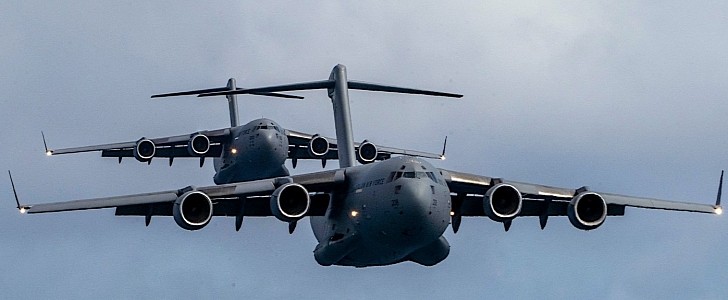In the very long history of the world, humans have imagined all sorts of crazy things. Why, at some point in the 1940s, someone even envisioned a flying elephant, who could take to the sky by means of massive ears. Little did Dumbo's creators know that decades later, such mammoth monsters, made by human hands, would routinely travel the skies.
They’re not elephants, of course, but one could easily associate the transport airplanes used by some of the air forces of the world with the heaviest land mammal, and wonder how on Earth they can stay in the air.
Case in point, this image here, showing two C-17 Globemaster IIIs as they come in toward the camera-wielding airman positioned just right to catch them on digital film forever. The first Globemaster, the one closest to the camera, belongs to the Royal Australian Air Force (RAAF), while the one further out is with the U.S. Air Force (USAF).
They are seen here, seemingly stacked, as they were performing “an aerial maneuver training mission around the Hawaiian Islands as part of Exercise Global Dexterity 2022,” held in early May at Joint Base Pearl Harbor-Hickam.
The Globemaster is not exactly the biggest military transport airplanes out there (that title goes to the C-5 Super Galaxy), but it’s not to be messed with either.
From the outside, the plane impresses with a wingspan of over 169 feet (almost 52 meters). Four Pratt & Whitney engines capable of developing 40,440 pounds each dangle from under the wings, and allow the Globemaster to take off weighing as much as 585,000 pounds (265,352 kg).
Inside, the beast can fit in a 88 feet/27 meters long cargo compartment a complement of 102 troops and their gear, or 170,900 pounds (77,519 kg) of cargo distributed on 18 pallet positions.
The U.S. has a herd of over 200 of them currently in operation.
Case in point, this image here, showing two C-17 Globemaster IIIs as they come in toward the camera-wielding airman positioned just right to catch them on digital film forever. The first Globemaster, the one closest to the camera, belongs to the Royal Australian Air Force (RAAF), while the one further out is with the U.S. Air Force (USAF).
They are seen here, seemingly stacked, as they were performing “an aerial maneuver training mission around the Hawaiian Islands as part of Exercise Global Dexterity 2022,” held in early May at Joint Base Pearl Harbor-Hickam.
The Globemaster is not exactly the biggest military transport airplanes out there (that title goes to the C-5 Super Galaxy), but it’s not to be messed with either.
From the outside, the plane impresses with a wingspan of over 169 feet (almost 52 meters). Four Pratt & Whitney engines capable of developing 40,440 pounds each dangle from under the wings, and allow the Globemaster to take off weighing as much as 585,000 pounds (265,352 kg).
Inside, the beast can fit in a 88 feet/27 meters long cargo compartment a complement of 102 troops and their gear, or 170,900 pounds (77,519 kg) of cargo distributed on 18 pallet positions.
The U.S. has a herd of over 200 of them currently in operation.







